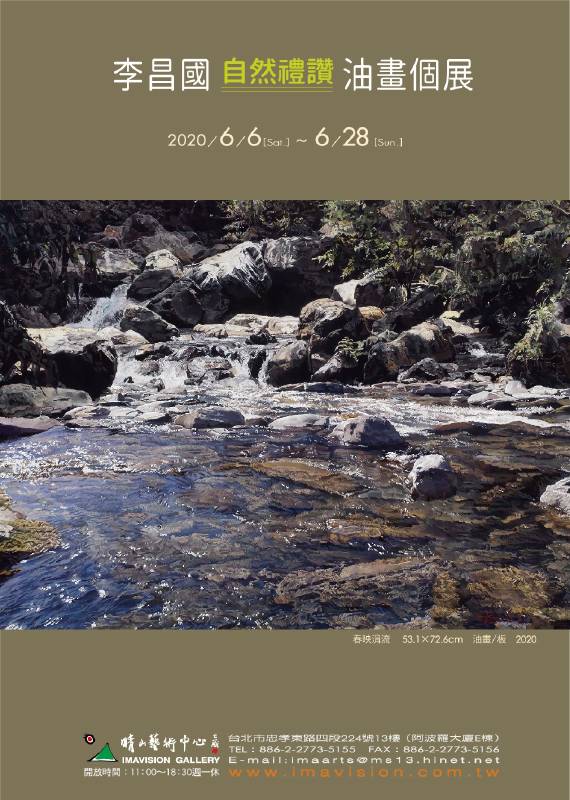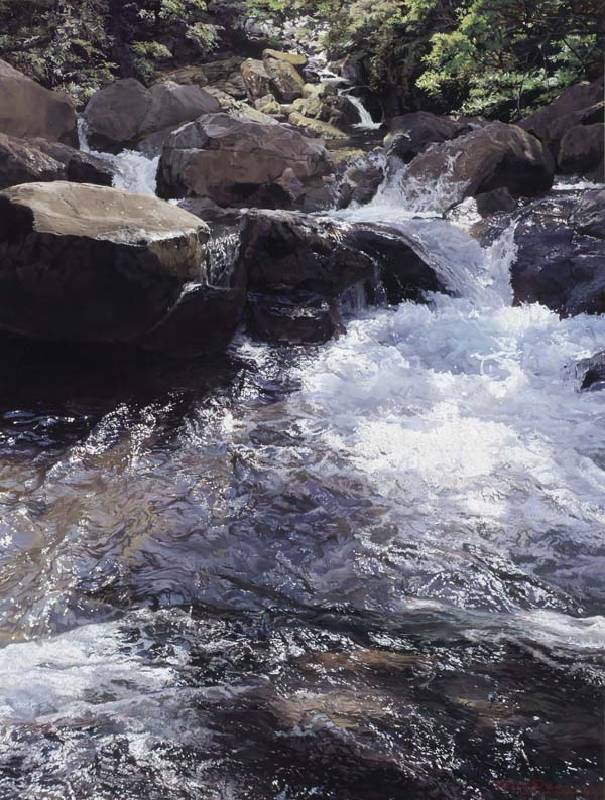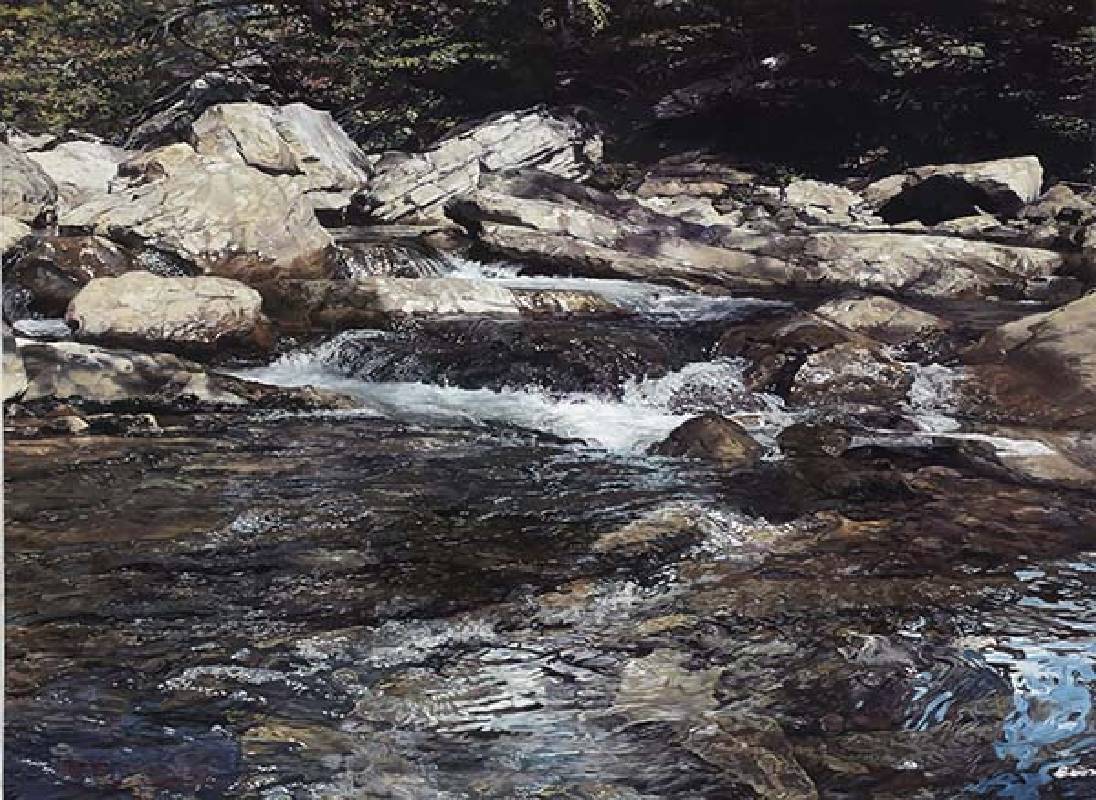-
Date
Date:2020-06-06 ~ 2020-06-28
-
Venue
13F, No. 224, Section 4, Zhongxiao East Road, Da'an District, Taipei City 106
"A Praise to Nature" Feel the timeless temperament of super-realistic oil painting
The development of aesthetic expression stems from the natural pursuit of human nature. Various forms of art models pursue refinement in their own systems and provide moving visual experience. Among them, "super-realistic oil paintings" have high thresholds in terms of materials, techniques, and structures. It has formed an irreplaceable charm and has a very special position in the category of visual art.
Qingshan Art Center once again invited the artist Li Changguo (1965-) to collaborate in 2020 to organize a solo exhibition of oil painting "A Praise to Nature" and publish a series of ultra-realistic oil painting creations. Starting from Li Changguo's experience of entering the forest, he perceives the movement of nature. With refined and strict oil painting techniques, rich layers of modeling, light, air, etc. are constructed. In different times and spaces, the sounds and colors of nature are recorded objectively and realistically. Let viewers follow the artist's brushstrokes to experience a peaceful, smooth, and calm spiritual state.
Li Changguo graduated from the Art Department of the Political Warfare School, then studied for a master of arts at the University of Salamanga, Spain, and obtained a doctorate from the Institute of Painting, Restoration and Preservation at the University of Seville, Spain. After returning to China, he became a professional artist and was employed as an associate professor in the Department of Visual Communication of Mingzhi University of Technology. From the impressionist painting style he was good at at first to the realistic and super-realistic artistic exploration, Li Changguo has gone through many transitions from watercolor to oil painting. Today, with the vocabulary of super-realistic oil painting, he has established his strong recognition.
During his master's degree in Spain, Li Changguo first entered the course of impressionist painting. During this period, under the guidance of the instructor, he focused on training "the adjustment of the relationship between light and shadow." By copying classic works in art museums, the mastery of contrast relations is strengthened. After completing the requirements of the college, the instructor gave Li Changguo a new topic of "abandoning inertia and expressing texture more quickly." Li Changguo also started from this, step by step no longer limited to the form on the picture, but more focused on the spiritual display in the picture.
Li Changguo, who is in the context of Impressionism, is in a period of vigor and vitality, and he naturally began to look for different creative possibilities. After consultation and research, the doctoral program chose a more stringent degree in painting, restoration, and preservation. I went to southern Spain and entered the most traditional classicism academy. At the beginning of enrollment, I locked the desired elective courses, and first entered the most rigorous professor's study and training. Starting from how to squeeze paint on the palette, step by step from material science to prosthetics, and then accumulate the cornerstone of creation from the experience of restoration.
After being recognized in the field of materials science, the instructor introduced Li Changguo to another professor's studio and entered the high-level human body depiction course. In the process, apart from re-studying anatomy, he also learned the secret of the ever-changing depiction of human skin color. Then he was introduced to a course specializing in still life painting, rethinking spatial relationships and "how to present the rules of air flow" from the origin. Even for the light or heavy texture of the sky, special courses are also taken for research.
During his stay in Spain, Li Changguo devoted himself to the knowledge and techniques of classical painting. The serious study of different topics step by step has given Li Changguo ample and solid drawing ability. When he finished his studies and was about to leave Spain, the advisor instructed Li Changguo in particular: "Don't think of yourself as a painter, but as a scientist. Scientists know how to do research."
With solid training in different subjects, Li Changguo has developed the habit of deeply analyzing the structure of objects. They often use a tomographic understanding and fully grasp the texture of the object before starting to portray. In order to manage more accurate pictures, Li Changguo also used experimental tools such as iron brushes to depict body and texture. Whether it is light and transparent or thick and steady, they are constantly looking for the most suitable way to paint. Over the years of practice, Li Changguo has summed up a super-realistic painting style that is different from American photographic realism. While being extremely accurate, it also gives the picture a more human temperament.
After returning from school, Li Changguo’s works at different stages, whether it is rural landscapes that focus on light and shadow, purely classical still life paintings, or Taiwan’s specialty crops, have laid out his background on the two cornerstones of science and aesthetics. The spiritual field of its environment. At the same time, it pays attention to the simple and simple or vast natural landscape, and then reflects the abundant layers and beauty. Perhaps it stems from the memory of washing clothes by the river with his mother in childhood, or the experience of serving in the navy. Li Changguo has an instinctive sense of intimacy with the vitality of running water (the moat that was not very mobile when he was studying in Spain, he was very close to Li Changguo. Unattractive). The series published in this exhibition naturally focus on the flowing water in the mountains. The materials ranged from Dabao Creek, Shiding, Taroko, etc. Li Changguo visited many streams with different characteristics. Through the rapid, rapid, and unpredictable currents, they communicate with their inner world.
Li Changguo, who works in the spirit of a researcher, perceives the similarities and differences between different landscapes. For example, between upstream and downstream, not only is the size or slope of the rocks different, the rocks on or under the water (different types) also show different states. Even the direction of the water flow, the force of the spray, the depth of the water, and the degree of transparency of the water quality have complex changes. Faced with such diverse visual elements, Li Changguo clarified these knowledge and feelings in all aspects. Brush by stroke is like photography, and it goes beyond mechanical visual vocabulary.
Looking back to the realistic painting in modern times around the world, the United States developed photographic realism in the 1960s. This painting style, which was originally based on acrylic paint as the medium, advertises absolute rationality. With strong visual effects, he proposed another reflection on photography that was different from Impressionism, which quickly attracted the attention of the arts and literature circles. However, Li Changguo's super-realistic paintings started from the classic oil painting aesthetics. It is not focused on purely objective representation, but has returned to the two primitive topics that humans can still "see the world" or "how to express the world".
Li Changguo's doctoral tutor was one of the pioneers who brought American photorealism to Europe. But in the process, its clear and sharp visual characteristics were eliminated. From the original point of the painting, the classical aesthetics' thinking of "environmental color" and the flow of air and charm is integrated into it. It opened a precedent for the development of hyperrealistic oil painting in Spain.
Learning from such an aesthetic system, Li Changguo's creation steps are quite complicated. From the pencil composition draft, the monochrome oil painting layer, the environmental color oil painting layer to the dyeing oil painting layer, on the wooden boards that have been used, each stage requires a high degree of concentration and caution. Following the ancient method and the interlocking steps are quite time-consuming, which makes Li Changguo accustomed to only create one work at a time. For a rough estimate of the size 15 (65 x 53 cm) oil painting, Li Changguo would need about 300 hours of work to complete.
In the rigorous painting method, every step is the key. Starting from the scale grid, Li Changguo believes that the pencil draft is the way to check and adjust the photographic materials, and it is also the starting point for creating visual dynamics and air flow. The monochromatic oil painting layer plays the role of examining the ratio of light to dark. Regardless of the lighter side and the darker side, it needs to be confirmed at this stage. The foreshadowing of this layer is also the pre-work that determines the visual movement and focus.
When the creation entered the stage of environmental color, Li Changguo regarded it as the core of creation. Following the training in the academy, Li Changguo insisted that environmental colors must be fluid, able to blend with each other, and establish standards for the overall atmosphere of the picture. When dealing with environmental colors, Li Changguo first dyed it quickly (more oil/high fluidity) in 30 minutes to blend the basic speed of the work. After the first layer of color is dry, gradually reduce the proportion of oil for each dyeing. The width of the brush will also become narrower and narrower from 8cm to about 1cm. This step approximately requires at least three to five layers of pigments to cover the step relationship between hue and time sequence. The details of the environment color will have a decisive influence on the translucent dyed layer in the next stage. The more detailed the blend of environmental colors, the more it can provide the visual "breathing sense in space" and further organize the persuasive beauty.
After confirming that the environmental color is complete, Li Changguo entered the detailed qualitative color layer. In a flat coating method that distinguishes color blocks, the perception of objects is stacked layer by layer. Plants have different distances between dryness and wetness, rocks on and under water, rapid or slow or turbulent currents, and light temperatures in the morning and evening are different. On the basis of the environmental color, three to five steps are used to reflect the characteristics of each element in the picture.
The treatment of the dye layer is a step that requires a lot of concentration and patience, and it is also a key to show the artist's painting ability. When the dyeing layer was nearing the completion stage, Li Changguo reorganized the smoothness of the picture again and again. On the one hand, reconfirm the visual movement in the picture, and also make the relationship between the various elements harmonious. In other words, on the basis of complete texture details, the contrast effects of modeling, hue, light and dark, and space are repeatedly selected.
Persevering in classical and super-realistic painting methods often requires extraordinary perseverance. Like the professors in the classical academy, Li Changguo strictly and regularly self-demands, and sincerely pursues artistic possibilities step by step. For Li Changguo, such an exploration process is quite interesting and happy. It is also a process of "breaking the barriers" in the inner world of encountering difficulties, trying to solve them, and constantly challenging them. Li Changguo believes that the handwork of realistic painting should be able to contain real humanity and attitude, and reflect the characteristics of the artist. Such work must be irreplaceable by machinery. Li Changguo hopes that his works will be fluent in visual reading. And while pursuing the realm of painting, it makes the viewer feel sympathetic and moved.
The solo exhibition of Li Changguo in "A Praise to Nature" is very delicate, providing a context of art history that viewers can read, as well as a clear aesthetic positioning that is appealing. It shows profound intentions on the axis of classical realism, and embodies the pursuit of a smooth and sparse mood on the axis of narrative lyricism. With the beauty of the natural environment, the classic and contemporary aesthetic philosophy are blended to shape a timeless poetry.



